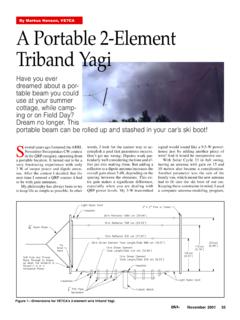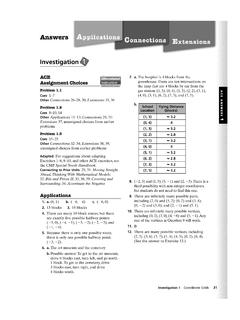Transcription of Zero's Rocket Stove Heater
1 The ZeroFossilFuel Rocket Stove Heater Theory of operation and assembly details. 2013 ZeroFossilFuel This document may be freely distributed, only free of charge and unedited. Let me start this document by saying that, if you intend to replicate my Rocket Stove , it is highly unlikely that any two replications will be exactly alike. That is as it should be because, if no one tried anything new, development would cease and there would never be any progress. If you've got an idea that you think will improve on my design, build it! If it works, please share it! What I will do here as best I can is take you through the steps I went through to determine all of the critical dimensions for building your own Stove based on the raw materials you may have found or bought.
2 The photos in this PDF document are fairly high resolution so they can be zoomed in to see finer details. So what is a Rocket Stove Mass Heater ? There is a wealth of information regarding Rocket Stoves all over YouTube and the web, and numerous variations on the basic design. I encourage you to do some research. Good places to start are and In the strictest sense, it is generally a wood fired Heater with an internal flue or riser, covered by a barrel of some sort with a long exhaust pipe that runs through a cob (mixture of clay and straw) thermal mass which acts as a heat battery, giving off stored heat in between burns usually between evenings and mornings when family are asleep and you don't want to be burning wood then anyway. Key benefits of a Rocket Stove over traditional wood stoves are: As little as 1/10 the consumption rate for the same effective heating to your living space, Virtually no smoke or carbon monoxide byproducts, just carbon dioxide and steam, Very little ash buildup with easy clean-out.
3 Variations on the design include the Pocket Rocket (I'm not terribly impressed with these) and mini Rocket Stoves intended for cooking. I will not discuss either of these here in any detail because neither of them conform very well to the original concept despite that they were named Rockets. Key features that truly define a Rocket Stove are: Vertical wood inlet to a small firebox, horizontal burn chamber, Insulated internal flue or riser, A drum or barrel over the riser for gases to cool and give off heat, An exhaust at the bottom that often extends through a cob bench to slowly store & release heat. How does it work? Very well, thank you. Okay, kidding aside, any wood Stove needs to create a draft to pull air into the firebox for the wood to burn. The average wood Stove sends 80% or more of the heat created by the fire up the chimney flue and out, giving off only left over radiant and convection heat transferred to the body of the Stove and into the room.
4 A Rocket Stove , by contrast, is able to scavenge almost all of that previously wasted exhaust heat without buildup of creosote or other deposits. Here's how. 2013 ZeroFossilFuel This document may be freely distributed, only free of charge and unedited. When a fire is started in the firebox of a Rocket Stove , all it should take is a puff of breath or two down over the firebox to get the hot gases to start traveling through the short horizontal burn tube and up the internal riser. Once they start upward in the riser the process becomes self sustaining. Here is where the Rocket truly differs. All of the draft necessary to make a well designed Rocket Stove function properly is created inside the internal riser. I cannot stress this point enough. From the moment the gases exit the top of the riser and down the sides of the barrel they begin to cool.
5 The draft created by the riser behind the cooling gases should be so strong that, not only does it pull in fresh air behind it, it also pushes exhaust gases out ahead of it without the need for any additional draft created by a typical chimney flue. This is why it is so critical that the internal riser (and even the horizontal burn tube) be as insulated as you can practically make it. By so doing it: Creates a super strong draft in a very small space and Provides the environment for secondary burn of any unburned gases Some say it creates a plasma burn but that's just not possible at the temperatures we're dealing with here. Even still, the combustion is complete and that's what counts. Smoke and odor are byproducts of incomplete combustion. A well designed Rocket Stove produces virtually no smoke or odor at all, has very low flue temps going outside and exchanges most of its heat into the living space.
6 So where do I start? At the beginning, of course. Duh! Okay, kidding aside again, the first thing you'll need is the tools (or at least access to them) and skills to use them. They include: Mig welder (flux core is fine or gas if you can afford it). Sheet metal bending brake. Mine is 30 . Tin snips. Angle grinder with grinding wheel and cutting disks. Drywall square. 12 bubble level Sharp indelible marker. Next consideration is overall size. Ask yourself How big of a living space do I need to heat? In my case it was just a 240 sq-ft well insulated workshop with about 2150 cu-ft of air space. So, I scaled down the overall size accordingly from typical whole house heaters that use 30 or 55 gallon drums. While scavenging through a couple of scrapyards I stumbled across a discarded 17 gallon air compressor tank.
7 PERFECT! Step 1. Find your own perfect barrel, drum or tank. 2013 ZeroFossilFuel This document may be freely distributed, only free of charge and unedited. This compressor tank for me was the ideal choice. Not only was it the right approximate size, it was rugged having 1/8 thick sidewalls. My tank measured 12 diameter and about 37 long. Other possibilities include discarded electric hot water tanks, artesian well water storage tanks, slim propane cylinders, stacked and welded 20lb propane tanks, etc. Be imaginative. Then I asked myself Self, what diameter riser could my tank support? With a basic understanding of cross-sectional areas required to make this Stove I figured anything from 7 - 9 . diameter would be good. This would leave a gap all the way around between - respectively.
8 In all honesty even 10 would fit and 1 gap going around would be plenty for the exhaust gases to exit freely. I settled on 8 because it was convenient and readily available. Step 2. Determine the internal sizes of your riser, burn tunnel and feed tube. Collectively this is known as the J-Tube. A typical 55 gallon drum Heater design uses a 8 inside diameter riser. A typical 30 gallon drum Heater uses a 6 inside diameter riser. Therefore, I. extrapolated that mine should be about 4 . I had read about others who had tried making 4 systems with mixed results. Confident that I could make it work I forged ahead despite the naysayers. I knew that I was going to use some sort of firebrick for the firebox and horizontal burn tube. My first concept for the riser was to use a 4 x 24 galvanized vent pipe as the inside wall of the riser with a 6 x 24 galvanized vent pipe for the outside wall and 1 of fiberglass insulation in between.
9 Several people expressed what I later decided were valid concerns over this choice I had made. They were: Emission of poisonous gases from the zinc galvanizing burning off, Short life span from rapid rotting under the extreme heat, Melting of the fiberglass wool. With the suggestions from others and knowing that many Rocket Stove builders use firebrick for their risers too, I decided to work through the design using firebrick as a liner and retain the galvanized pipe outer wall. To do so I wanted a cross-sectional area as close to a 4 round pipe as I could get which is sq-in. Bricks arranged to get x square tube ended up being sq-in. Close enough for government work. The final drawing illustrated below shows exactly how I arranged my bricks to achieve this opening size.
10 2013 ZeroFossilFuel This document may be freely distributed, only free of charge and unedited. Everything else about the internal dimensions is all about ratios and cross-sectional areas. In a nutshell, the cross-sectional area that the hot gases must pass through should be the same or increase slightly at every point along the path with the exception of the area between the riser and inner tank wall which is often much greater. So, starting with my riser of x : horizontal burn tube area should be < or = the riser. Mine is x ( sq-in). Firebox opening also should be < or = riser but not < than the burn tube. Mine is x . Area at the top of the riser should be between to 2x the area of the riser itself. Area of the exhaust port should not be < area of the riser.








